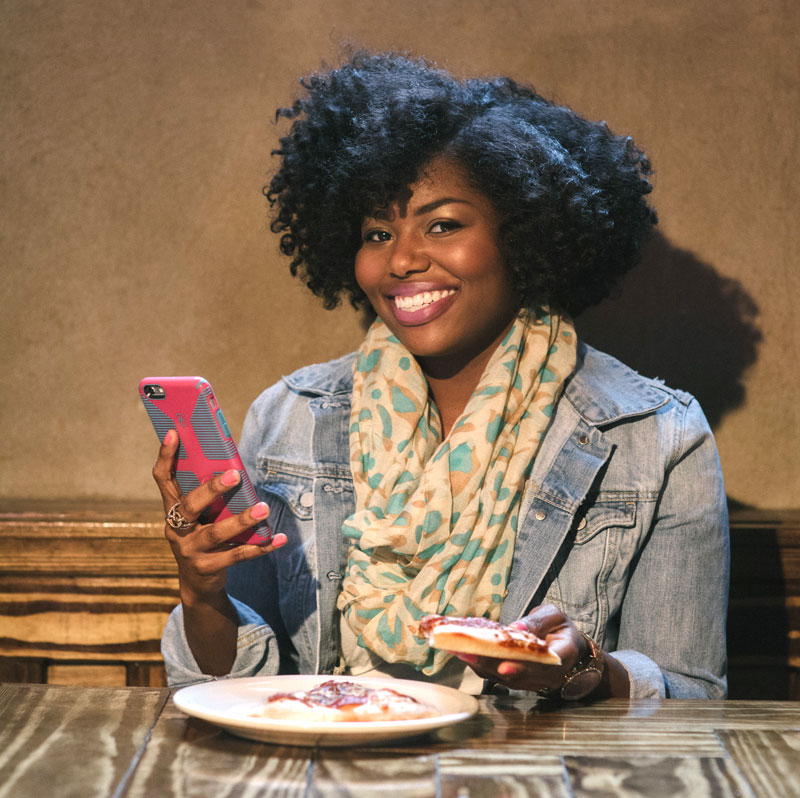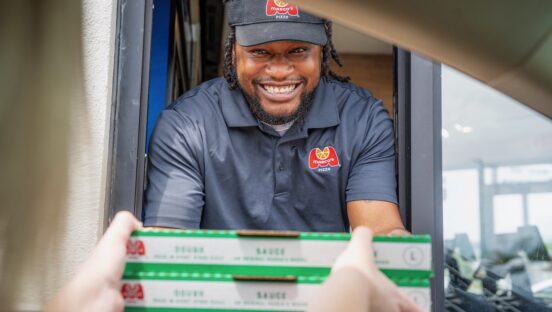Call them entitled, tech-dependent or self-absorbed, but one thing’s for certain: Millennials now wield serious purchasing power. According to Barron’s, this group of more than 86 million young souls (those born roughly between 1982 and 2004) eclipses the baby boomer generation by almost 10%. As Kane Russell, head of marketing for Thanx in San Francisco, puts it, “Millennials are the country’s largest-ever demographic, with more spending power ($200 billion) than any other demographic in U.S. history. Pizzerias cannot survive without them.”
Who Are They, Anyway?
If you’re going to market pizza to millennials, you need to know who they are, how they’re evolving and what matters most to them. Millennials aren’t some cultlike monolith with a single world view, but, according to Linda Duke, CEO of Duke Marketing in San Rafael, California, they do share some key features. For starters, they’re becoming bigger earners and forming families (46% of U.S. households headed by a millennial adult ages 20 to 34 have kids). They’re more technology-focused than previous generations. They like to buy locally, even if it’s more expensive than mass-market alternatives. And they place an emphasis on fresh and organic foods, variety and customizable, personalized meal experiences.
 |
|
Millennials like Alison Green, shown here at the Blind Pig in Oxford, Mississippi, don’t like to think of themselves as mere consumers. They value authenticity and individuality and want to be treated as co-creators of their favorite brands. Photo by Danny Klimetz |
Beyond these generalizations, they’re a somewhat motley bunch—the most diverse generation of adults in U.S. history, according to Jason Dorsey, millennial and iGen expert with the Center for Generational Kinetics in Austin, Texas. “It’s a priority to [let them know] that you understand they value and appreciate diversity and that diversity helps to make the world interesting, fun and full of adventure,” Dorsey says. “This could be as simple as presenting more diverse customers [in your advertising] or offering products that proudly include different cultural preferences. With millennials, a one-size-fits-all marketing approach fits none.”
Jeff Fromm, president of FutureCast in Kansas City, Missouri, and co- author of Marketing to Millennials & Millennials With Kids, agrees that millennials are not a homogeneous mass. “Our latest research found that 64% of the affluent millennial population is female,” he notes. “Addressing this generation as if they are all the same and not taking into consideration their different life stages and life objectives is a huge miss.”
Millennials as Co-Creators
Still, marketers can zero in on the traits that millennials have in common. We know they don’t like to think of themselves as mere consumers—they’re part of your brand. “Education and participation are key with millennials,” Duke explains. “They want to know where their food comes from and how it’s made, which encourages engagement and solidifies brand advocacy.”
Fromm agrees, adding, “Millennials believe wholeheartedly in co-creation. These young adults have grown up with greater access to brands than ever before and feel a sense of ownership that previous generations did not. Thus, brands need to address millennials as partners rather than consumers. Brands create a more authentic message when it’s created by the people they’re targeting rather than for them.”
Start by telling your brand’s story and focus on key messages, such as high-quality ingredients and local sourcing, Duke says. Try to make an emotional connection through your displays, kiosks and packaging. Host events such as contests, drawings, bounce-back offers with a purchase, or cooking demos.
 |
|
Millennials favor brands that demonstrate genuine support for social causes, such as the environment. |
Keep in mind that, because millennials are the most advertised-to generation in U.S. history, they often see right through traditional advertising campaigns. But they’re also more excited when they find a message, ad or campaign that resonates with them, Dorsey says. “The key is to not talk down to millennials or present that you know what’s best for them. Instead, try to speak to their individuality—and let them comment back. That means using digital platforms, including social media, to communicate your values, mission and the people behind your brand in a way that shows you’re real and credible.”
Authenticity is paramount. “Millennials can spot a fake from a mile away,” Dorsey adds. “Ask them to be involved in your brand, mission and values, and let them know that you’ll listen and engage them by meeting them where they are.”
Let Us Entertain You
Mobility is another key to this demographic. Russell notes they spend at least 25 hours per week online and tote their phones everywhere. “Pizza marketers have to go mobile to market to millennials,” he says. “Ninety percent of them have their mobile device in arm’s reach 24-7.” His advice: If you don’t have a mobile strategy in place, work to build one; then make your content, including website, social media and emails, more entertaining. “Gawker reported that 80% of millennials want brands to entertain them,” Russell says. “Entertainment value makes marketing campaigns interruptive, while also making them worth the time invested.”
Russell offers two ways to make your engagement more entertaining: 1) Target your writing style to millennials, using brand- and demographic-appropriate language. Make announcements and updates brief and relatable (generic updates loaded with buzzwords miss the mark). 2) Introduce useful gamification. Bells and whistles can quickly become a waste of time, so stick with elements that provide utility—for example, an easy-to-find online portal with a status bar that displays loyalty reward progress earned, with the bar changing color as a customer gets closer to the goal.
“Millennials do not see their smartphones as only a form of communication,” Fromm says. “It’s their Swiss Army knife that helps them to navigate nearly every area of their lives. The question is, how quickly can you get a mobile strategy? It’s not just apps and video games; focus instead on creating exquisitely designed mobile sites that feature a high level of user-experience drivers.”
Choose Your Social Channels
Duke reports that millennials are more likely to explore brands on social networks—53% percent versus 37% of other generations. But Kamron Karington, CEO of Repeat Returns in Las Vegas, believes most pizzeria owners see little ROI from Facebook and social media in general, since social media is overwhelmingly occupied by friends and family. Hence, becoming a “friend” by making posts more personal (for example, about you as the owner) allows you to promote your business in stealth mode. Just don’t try to be everywhere at once. “Owners can’t keep up with every social platform out there, but they can make it easy for customers to use their favorite social platforms to spread the word about the business,” Karington says.
Russell agrees that brands can get carried away trying to launch content across too many social media platforms. His advice: Start with Facebook and Twitter. Then experiment with video content; if you find success, invest in video-centric social media channels like Vine. “Regardless of the social media channel, millennials respond to authenticity,” Russell says. “They’ve grown up accessing information on demand, and they expect that same authenticity and transparency from their favorite pizza brands.”
Just remember this: What really drives social media activation for millennials is good content. “Your approach to content will make or break your marketing communication efforts, and social media is simply one way to activate your content strategy,” Fromm says. “The goal should be obtaining the best possible understanding of your consumer to reach them where they are rather than ask them to come to you. Yes, Snapchat might be all the rage right now, but it might not be the best channel for your specific audience.”
In fact, Facebook, although still used by millennials in huge numbers, has been losing steam, Dorsey points out. Today, Vine, Snapchat, Instagram and Pinterest are more of-the-moment. “Look at your industry and identify the brands that are doing it right—see which channel is the most successful for them,” he suggests. “Yes, there’s value in being first, so when an opportunity arises, definitely experiment quickly. But the most popular outlets are already being used by millennials in large numbers, so you can see what’s working.”
Dorsey recommends picking one or two social media channels that fit your audience and sticking with them rather than trying to handle five different outlets. “With social media, it’s not about quantity of posts, but quality of posts and engagement,” he concludes. “Give people a reason to connect with you and stay connected, and they will. Blast them with your latest ads constantly, and they’re not going to follow you. Being social is about bringing up the humanity of interaction around your brand.”
Creating a Two-Way Relationship
With the rise of crowdsourcing sites like Yelp, Karington believes millennials are more in charge of your marketing than you are these days. “Yesterday, it was buyer beware; today, it’s seller beware,” he says. “Any perceived slight travels to a wide audience in the blink of an eye, and millennials expect to hear back on a complaint within hours—not tomorrow.” After all, the secret to any happy relationship is listening. Therefore, you’ll want to provide easy conflict resolution (a link on your website or a phone number for complaints) and offer occasional surveys to solicit feedback and prove you care about their opinions.
Don’t sign up for social media if you’re not prepared to listen to your customers and respond to them quickly, says Sameer Shah, VP of marketing at Austin, Texas-based Smart Flour Foods, which produced the study, Pizza Lovers in America 2015: Unexpected Findings From a Generational Look at Pizza Trends. Be positive and up-front, sharing as much information as you can. “Answer negative comments in a friendly manner, versus negatively or defensively,” Shah recommends. “Never hide negative comments; responding to them positively is an opportunity to shine, and hiding them will only make you look scared and weak.” For example, if a customer reports a bad experience at your pizzeria, say, “Thank you for the feedback! We appreciate you taking the time to reach out with your concerns, and we’re sorry you didn’t have a better experience. We have communicated your concerns with our management and will make the appropriate changes necessary. If you would like to give us another chance, your next meal is [30% off, free, etc.].”
Creating a two-way relationship between your brand and millennials establishes trust and can even turn bad experiences into positive ones. For example, you can use mobile notifications to solicit feedback from your customers immediately after they make a purchase and respond to any pressing issues or complaints as soon as possible. Instead of heading straight to Yelp to complain about a problem, the customer gets instant gratification and will be less inclined to trash you online. Now, Russell notes, “your proactive customer service becomes an asset of your Yelp review, as opposed to a shortcoming. Recent studies show that soliciting and replying to feedback via mobile increases sales by 22%.”

Make the World a Better Place
As Shah points out, millennials don’t just like open communications; it’s all they know. Hence, companies should use their social channels to communicate who they are and what they’re doing day to day. “Transparency and communication shouldn’t just be about the big things,” he says. “So, for example, share pictures of your kitchen online. Show support for social movements or advocate for social causes. And share your successes and milestones to make customers ‘part of the team.’”
Russell also recommends offering more socially motivated benefits—for instance, let customers vote on which charities will receive your company’s financial support. You can even let them choose whether to apply loyalty rewards savings to their own bill or contribute that money to a social cause—and if you really want to prove that you care, you could match that donation. Fromm notes that 45% of millennials believe it’s easier to contribute to a charity they care about through a company’s program rather than on their own. This creates a huge opportunity for brands to create social programs that align with millennial core values. “By embracing their favorite brands as partners, millennials believe they help make changes that will make the world a better place,” Fromm says. “Green initiatives and gender and racial equality have been a main focus of millennial philanthropy recently.”
The millennial mindset is admittedly complex—it’s one part altruistic, one part self-absorbed, easily distracted but adaptable, and genuinely curious about the world at large. If you don’t fully “get” them yet, it’s OK. Just don’t fake it. They’ll see through that in a flash and won’t like it. Always engage with and respond to millennials in a way that makes sense for your brand. If you take away one buzzword from this article, make it “authenticity.” Like your mom always told you, just be yourself. “If you attempt to speak to millennials in a language—slang or other—that doesn’t fit naturally with your company, you will quickly be ignored,” Fromm says. “They’re adept at sniffing out phonies.”
To summarize, just keep it real. “Focusing on quality over quantity will push your message to the right group of consumers that genuinely want to engage—rather than just adding to the market noise,” Fromm concludes.















